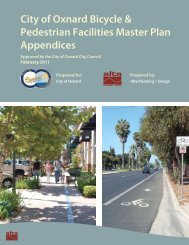View File - Development Services - City of Oxnard
View File - Development Services - City of Oxnard
View File - Development Services - City of Oxnard
You also want an ePaper? Increase the reach of your titles
YUMPU automatically turns print PDFs into web optimized ePapers that Google loves.
WATER RESOURCES TECHNICAL REPORTindividual aquifer layer or zone, and allow evaluation <strong>of</strong> the seawater intrusion problem. Inthe 1990s, the USGS constructed 32 multiple-well monitoring sites in the western part <strong>of</strong> theSanta Clara River Valley and monitored 29 existing wells to gather data on geology, waterlevels, groundwater quality, and aquifer properties at different depths. In 1996, the USGSbegan the computer modeling study <strong>of</strong> the Santa Clara-Calleguas Basin. The results <strong>of</strong> theongoing RASA program in Ventura County, which have been important to understandingthe groundwater resources <strong>of</strong> the Santa Clara-Calleguas Hydrologic Unit, are documentedin a number <strong>of</strong> USGS reports.2.3 ClimateCoastal Southern California and Ventura County have a Mediterranean climate regimecharacterized by a long, dry, warm summer season followed by a shorter wet winter periodaccompanied by cooler temperatures. Average monthly precipitation and average monthlytemperatures are shown in Figure 2-4 for three meteorological weather stations withincreasing distance from the ocean and elevation: <strong>Oxnard</strong> (046569), Santa Paula (047957),and Ojai (046399).2.3.1 TemperatureTemperature extremes generally increase with elevation and distance from the ocean(Figure 2-4). Average high temperatures for <strong>Oxnard</strong>, Santa Paula, and Ojai are 70.1, 74.6,and 77.7 degrees Fahrenheit (°F) and average low temperatures are 51.0, 47.8, and 45.8°F,respectively. The growing season, or lapse <strong>of</strong> time between killing frosts, is long, andgenerally decreases with elevation and distance from the ocean. Certain areas produce asmany as three crops per year because killing frost on the coastal plain is rare.2.3.2 PrecipitationMost precipitation occurs in the winter months during a few major storms. Approximately85 percent <strong>of</strong> precipitation occurs between November and April and generally increaseswith increasing ground surface elevation (Figure 2-4). Average annual precipitation for<strong>Oxnard</strong>, Santa Paula, and Ojai are 14.77, 17.84, and 21.18 inches respectively. Precipitationexceeds 25 inches in the higher mountainous areas where some snowfall occurs in mostyears.The 114-year annual precipitation record for Santa Paula is shown in Figure 2-5. This recordprovides annual precipitation by water year from 1890 through 2003, the 114-year averageand median precipitation, and the cumulative departure from the 114-year averageprecipitation. These data are collected and maintained by UWCD at gauge No. 245. The114-year average and median precipitation values are 17.38 and 14.89 inches, respectively.Daily evaporation measurements are recorded from a standard Weather Bureau Class A panat the UWCD El Rio spreading grounds. The average measured evaporation rate is59.31 inches, approximately 3.5 times the average precipitation.Precipitation records show shorter- and longer-term cyclic patterns <strong>of</strong> dry periods and wetcycles. The shorter-term cycle is known as the El Niño/Southern Oscillation (ENSO) and thelonger-term cycle is known as the Pacific Decadal Oscillation (PDO). Multi-year dry periodsare indicated in Figure 2-5 by declining cumulative departure values, and correspondingW112003002SCO LW1458.DOC/ 033390002 8
















